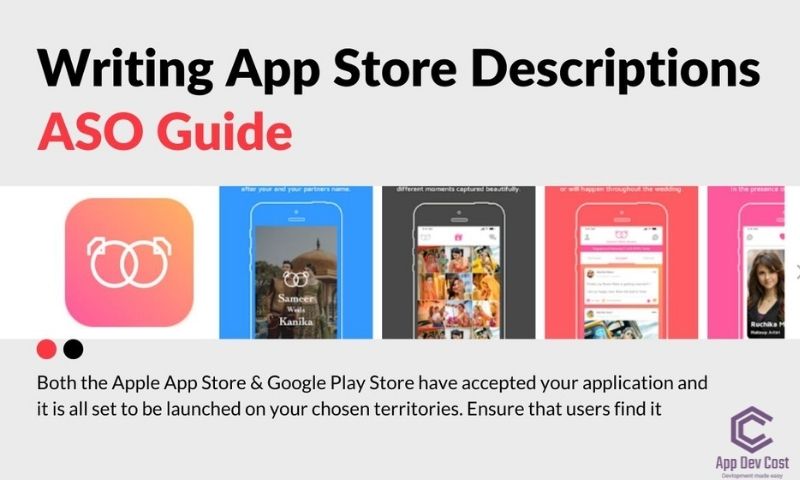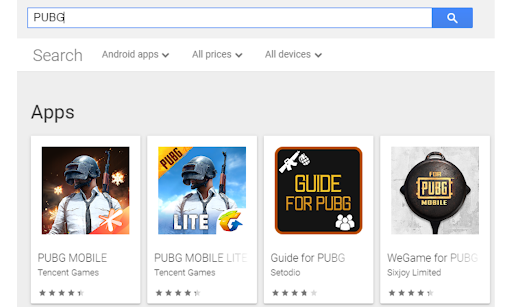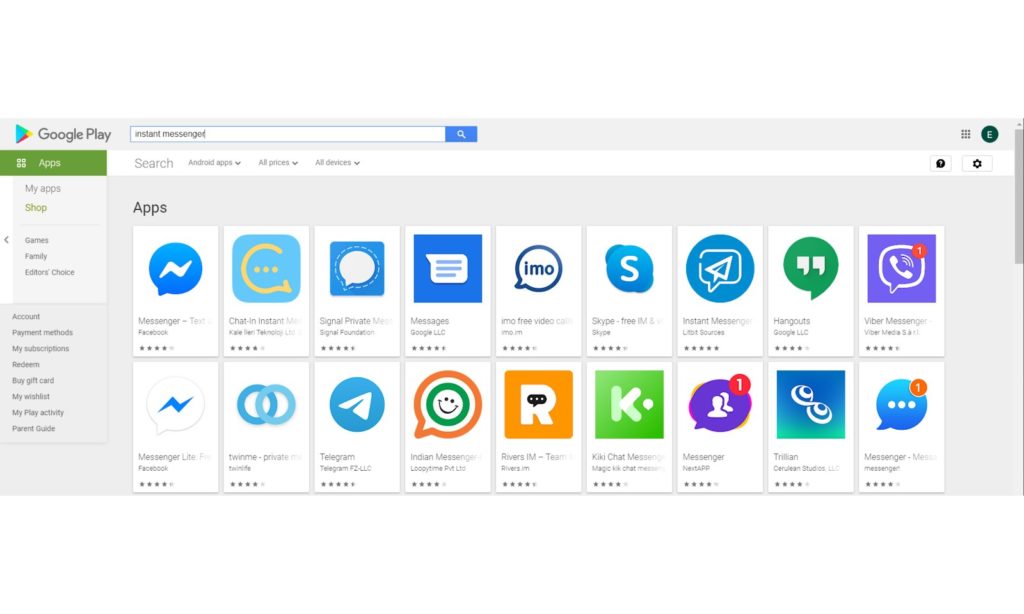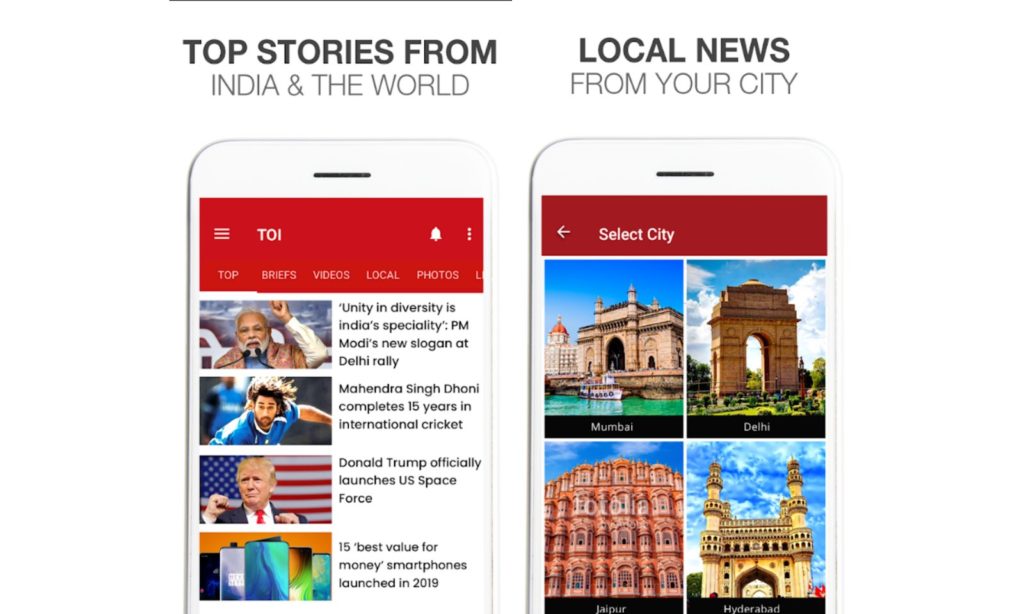Both the Apple App Store & Google Play Store have accepted your application and it is all set to be launched on your chosen territories. You now have to ensure that users find it since the hard work of creating this concept is over. That ought to be a simple task, right?
Well, each application has different fields to make it visible for certain keywords that are most often used by users in their search. This implies that all these fields must be filled out as needed so that the application is easily visible to users on both the application stores. Luckily, you have the overview to help your potential users identify & clarify the core functions of your app and make it more noticeable in the app stores, especially when the users are looking for the applications from your niche!
Well, writing an app store description can be far more difficult for anyone than you think. Maybe you’re grappling to figure out how you can best describe your mobile application or maybe you’re wondering what keywords should you incorporate in the description to make it as visible as possible. Is it too short a description? Or is it way too long? Is that even meaningful? Thankfully, techniques like the best ASO technique are available to compose the perfect description of the app stores. Simply adopting these guidelines for writing the app store descriptions will significantly impact the app’s visibility for high-volume keywords.

What Are The Key Components Of The App Description
To start with, there are 3 main components of writing the best app description possible. They are:
- Application’s name
- Application’s description in the app store
- Application’s screenshots attached
There is no one particular or ideal way to write a description of your application, but certainly, there are numerous awful ways to do so. To prevent you from making those disastrous mistakes of describing your application in a bad manner on the app store terribly, we have gathered how-tos and how-not-to.
Let’s have a look at them:
1. Your Application’s Name
First and foremost, the most important part of your app’s description is the name of the application itself. For obvious reasons, you want your customers to be able to find your application on the respective app stores just via the name. And the only way to do this is by picking up the correct name for your application

The title of your app will represent two or three of the most significant–and distinctive–characteristics of the app. Keep in mind that the title of your application shouldn’t be more than 100 characters. You should also ensure that keywords are included in the title text. This helps your potential users to find your application on the App Store and in the Google Play Store without much of a hassle.
2. Your Application’s Description
Now, there are certain key pointers which one should keep in mind while writing the description of their mobile application. They are:
- The key concept of your product should be well-described in the initial 1–3 sentences of an app Description. Through explaining the issue the application fixes, you will make this section way more engaging. Bear in mind that the combined total number of characters in the first 3 sentences shouldn’t surpass 225 characters in any plausible case.
- Now after that, it is nice to boast about the application a little too much. Let your potential users know if your app was featured on any popular website, or it received an award or whether Donald Trump is talking about it.
- Then following this should be the summary of your application which can easily be of two to three paragraphs in which the characteristics and descriptions are described.
- After doing so, now it’s time to describe some of the key functions of your application.
- And lastly, there should be a “What’s New” section in which all the new updates made to the application are concisely mentioned.
3. Your Application’s Screenshots
The most critical to take care of when attaching the screenshots is the first screenshot. It should be able to explain what exactly your application does. Then you can add some more screenshots which showcase even more features of the application, the user interface of the application, and various in-app screens of the applications as well.
Also, keep in mind that when you should use verbs when inserting text in your screenshots. This is simply because verbs encourage people more than any other part of the speech to take action. So, when talking about descriptions – your mates are verbs.
Here’s How To Write App Description (Pro Tips)
See, we get it, writing an application’s description in the utmost precision is not a child’s play. There might be a number of things going on in your head like from where should you start, how can to craft a compelling app description that holds the power to you know, persuade the readers to actually download the application and use it.
But worry not, because we got you covered. In this step-by-step guide, we’ll be giving you the best tips possible, using which you’ll be able to write a killer app description So, let’s get started.
Tip #1 – Ponder Upon Your Mobile Application
- Ask yourself, “What Is My Application All About?”
Before you jump straight away into writing the description, we’d suggest you wait for a minute or two. This is simply because there is a 90% possibility that you might not be an actual writer. So, don’t leap into the description right away, but wait and think about your mobile application.
Now, the best thing you can do is to use your mobile application for some time, and do it as if you’re a potential user. Think from a customer’s perspective and you’ll get an idea of what all a user should know about your application. After doing so, now it is the right time to fire up your laptop or grab your pen. But again, don’t start writing just a normal description of your application!
But instead what you can do is to take a step back and ask yourself these 4 questions about your application:
- What exactly does your mobile application do?
- Which customer problem does your mobile application solve?
- What is unique about your application what separates it from the rest of its competition?
- Why should any person download your application rather than going for any other possible alternative?
When you’ll be done writing the answers to the aforementioned questions, read the answers once again. These answers, which are basically your own words will help you get into the right mindset – and that’s what will help you in writing a killer description for your application.
But these questions are for any general application. If your final product is a game, then you can consider asking yourself the following questions:
- What genre does it belong to?
- What is the best feature of this game?
- Would you love to play this game?
- What separates it from the rest of the competition?
- Where is the challenge in your game?
After doing so, you’ll have a solid idea of your own application, now you can start writing the description. But before you do so one last step – try to think about what the users might be interested in reading about the application. Think of something that would catch their eye, think of something that would incite them to down your application and use that to write the description.
- Getting A Second Opinion Won’t Hurt, We Swear!
You are going to be very close to your app as a developer; you are probably going to be so close that you will blind-sighted to the flaw in your own application. This is why it is important to receive some other opinions, preferably from people without a strong interest in the success of the application. Begin with asking your friends and family about what they think of the application, but bear in mind that they are likely to sugarcoat things just because they don’t want you to feel bad or disappointed.
In case you have already launched the application, you can go through the reviews for some genuine feedback. After going through the feedback you’ll learn that different people have different opinions about your application. Being the developer or the owner of the application it is your duty to consider all the positives and negatives and stir them into the application. It is definitely something you want to look on, if many people seem to be happy about a specific feature or if all of them comment on a character or one backdrop in a game that they like.
This external perspective is very relevant and, in some situations, it may be better to hire an experienced writer or business to do the application description for you.
Tip #2 – Consider The Keywords & Keep An Eye On Your Competitors
- Taking The Keywords Into Account
Before you dive into the writing process, there is one more thing to do. The good description of the application isn’t just about persuading the potential users to download the application. ⠀In fact, what people don’t understand is it can highly increase the chances of the application appearing in the search results. In your description, you’ll probably want to sprinkle some essential keywords naturally so that they don’t look like they have been forcefully inserted in there.

Do not be tempted. Unnatural word insertions can scare the readers, so keep them in mind when you write. In the simplest words, you would want to use those words which people are likely to type into the app store’s search box.
- Keep An Eye On The Competition
Well, find out some of the most popular applications in your app’s niche and go through their descriptions. Maybe you would like to look at the biggest competitors in applications or games It is really important to keep the description of your application unique, but there is no harm in taking some inspiration from other key player’s descriptions.
Compare the descriptions with your application experience. How do they match? This exercise will give you more insights and may ignite some more ideas about how best to showcase your submission. It might also produce some ideas for other keywords you would like to use.
Tip #3 – Writing Badass Descriptions
- Think Of It As Your App Store Elevator Pitch
Like an elevator pitch, your app store description also needs to be on point, straightforward and persuasive at the same time. This is because if someone is taking a couple of minutes out of their time just to read your description, he is giving you an opportunity to convince him by telling him why he should download your application.

Hence NO BS, cut straight to the point in the most appealing manner possible. Here the biggest limitation you have the screen size because by default only one or two lines are displayed. To read more the users have to tap on the ‘Read More’ button. But most people search and download apps on their Android smartphones or iPhones directly.
- In Apple’s App Store, there is a character limit of 225 only.
- This gets even worse on Google’s Play Store as you have only a 90 character limit in the metadata field.
- Then in the full description space, both Apple and Google give you a total of 4000 characters to describe your application.
- The Promo Text
This is the first text that you’ll write for your application and the most important one as well. Google allows you to finish it in 2 lines whereas Apple gives you 160 characters to curate it.
A general understanding of how the app is should be conveyed by the title and screenshots. It should instantly click to the reason and should tell him why your app is what they should download at the moment.
- Dive A Little Deeper
You have built an exciting opening that reveals what people can expect and should expect if they download your app. Now you should explain all the main characteristics of the application to them. Follow the rules of your newspaper and extend your app’s description from the most important first and least important items at the last.
If you want your description to act well, then it should read well. Read it and check whether the text flows naturally or not. Make sure there are no typos or spelling errors in the description. A smart way to check the flow of your description is to read it out loud.
Also, there is a possibility that you might be tempted to exaggerate about your application, but don’t. This will do nothing but backfire later on because over-exaggerated text will set unrealistic expectations, which are obviously not going to meet ever. Hence, angry or disappointed users will flood the feedback form with bad negative reviews against your application.
Keep in mind that no one likes a massive wall of text, which is why you should think about how your text is going to look on the description page as well. Some of the tips & tricks which you can use to make your text look better are:
- Giving which spaces while keeping the paragraphs shorts.
- Using headings, sub-headings and proper formatting.
- Making good use of bullet points. But don’t use more than 5 or maximum or 7 bullet points. Also, keep the most important points in the first two bullets.
Make Good Use Of Customer Testimonials & Social Media Promotions
We would suggest you consider including testimonials and certain related relevant related links at the end of your application description
Showcasing your customer’s testimonials is one of the most effective ways of getting more downloads as it subconsciously builds a trust factor. It is a really smart yet clever move to showcase the awards your application has won, or if it was featured by some really popular and reliable website.

The reliability of the source and the likely impact on the readers must be taken into account. Sometimes a review might summarize all about in your application in a lyrical & concise method, use those!
Lastly, add the links of your social media accounts, the website of your company etc can also be added to the bottom of the description. By visiting those links, the potential users will be able to gather more relevant information about your application and company.
Tip #4 – Practice The Final Finishing Moves
- Add Some Local Touch To The Description
Well, the cheapest and the simplest way to make the most out of your well-written app description is giving it a local touch. This is simply because everybody likes to read in their local language, hence, with everything they read in their local language, they connect with it better.

Hence, writing the app’s description in the local language of your target audience or giving it a local touch will highly boost the chances of you getting more downloads. Make sure you have a professional provider for the translation of the app description. A direct word-to-word translation will not be as nuanced and sophisticated as your original description.
- Keep It Updated, Always.
Every time you update your application or your game, it is a smart practice to update the description of the application as well. You can showcase all the changes made in the application in written form in the app’s description.
You can also update the description based on the kind of feedback your application is gathering. If people are complaining about any particular thing, you can give a possible explanation about the same there. Or if you hit a big milestone, like your first 1,00,000 downloads, you can mention a thankyou note in the description there!
By taking all 4 tips mentioned here into consideration, you’ll be able to create a badass description, which actually sells!
Bonus- What Are The Description Writing Mistakes You Should Avoid?
Description writing is cool, now that you have all the key tips and tricks, you think you’re eligible enough to go ahead and start writing the description? Well, yes, you are partially right. Even though you are well aware of the DOs of the app description writing, you still have to know the DON’Ts of the same.
So below are the major mistakes to prevent when drafting an App Store and Google Play application description:
Mistake #1 – Underestimating The Power Of Screenshots
Your potential users are generally browsing the app stores on small mobile screens most of the time, as we mentioned above. The users of the app store are generally drowning in pool information with a very short attention span, hence they scroll away pretty quickly. You must be careful with the screenshots as they not just have to catch their eyes but also to showcase your work’s quality as well. Do not be hasty with your screenshots, especially after you’ve spent time making a wonderful app. You function like your app’s window display. On each store they have to be of optimum resolution. So that they look good, and do their thing as well.
Believe it or not but the 1st screenshot is the most important one. It must make the users want to see the rest of them first, and also to convince them to download the application. If your screenshot uses text, opt for action verbs that encourage you to go further.
Mistake #2 – Bad Description Writing
The texts must be unimpeachable for conveying a serious picture. Sometimes, any form of typing or spelling errors will put off your future users. This, in most cases, will do nothing but negatively impact the odds of your application being a successful one. The description can have up to 4000 characters in both the App Store (iOS) and the Play Store (Android). Making a mistake or writing a word twice is pretty easy. Ideally, have someone else by your side and have them proofread the entire description before you upload it. Because once published, it will be too late to make any changes, especially if people have read it and passed by your application because of it. Once sent, you’ll have to resubmit your application again to the respective stores, and it will be a shame to resubmit your application simply because of minor spelling errors!
Also, it will be a smarter move to keep the content platform oriented only. For example, using words like ‘iOS’ or ‘iPhone’ or even ‘Apple’ on your Play Store description or vice versa isn’t the right thing to do, because such things can lead to the rejection of your application.
Mistake #3 – Not Describing Your Application Briefly
You need to learn how to be a pedagogue especially when you launch your app. Users need to be able to understand the purpose of your app and what they can gain from using it in less than a second.
Don’t neglect to be as concise as necessary, placing the points in perspective or giving examples. Even if certain things seem apparent to you, mind that not everybody is an expert in your field. It’s obvious this to attract the most people, you must remove as much technological or “business” terminology as possible. Don’t let your passion or desire to sell overwhelm your judgment. Just define the functionalities. The app can be removed as quickly and as downloaded. If you don’t keep your promises, then your customers will be frustrated and their smartphone will delete your device.
Mistake #4 – Forgetting The Most Important Thing, To Sell Your Application
By the time you fill in the description, you’re reaching almost the end of your project. But don’t believe it guarantees the success of your application on the app stores. You need to persuade potential users to download and try your application. And to do so, you need to be able to sell your application simply with your words!
And that is then the texts come into play. There are 4 key things that you need to consider if you genuinely want to persuade people to download your application. They are:
- Title & Subtitle Of Your Application
The most significant texts are the ones that are visible without even opening the app’s page in the store. Hence, here your text should be able to define your application in the simplest and the easiest way possible. So -be as simple and straightforward as you can with the title and the subtitle of your text. Keep them short, but super crisp. You will show the name of your application in the title and subtitle, and possibly a memorable and simple slogan. Just remember, if the person isn’t able to understand what your application does, he will not open the description of the app in any given scenario.
- The Main Description Of The Application
The “Promotional text” is extremely valuable on the App Store. It enhances your subtitles and builds interest & curiosity amongst the users. Make the most of this field to really advertise your app. Add any honors you might have received, any mentions on a popular website or blog.
In the rest of the description, you can add more information about your application. But don’t do too of it as well. If you feel like doing so, remind yourself that the users will be reading it all on a small screen, and adding too much text will do nothing but put them off. Going with a short paragraph with a maximum of four lines in it, using bullet points or lists is the best way to. Make careful use of capital letters. On the Play Store, the title can include Emojis as well but follow the same rules as the capital letters. But the thing about Emoji is, you should not be using it if your target audience is kinda professional.
- The Keywords
For the indexation of your application, the keywords play a really important role. In Apple’s App Store, it is possible to add tags with your application to improve the visibility of your application in the searches. But don’t forget to overuse the tags or the keywords, as it will create a negative image of your application in the app store. If you really want to stand away from the crown, be precise, use tags or keywords, but be mindful while using them. For example, if you have a puzzle game on the app store, don’t just use the ‘Game’ hashtag with it. Include meaningful hashtags like ‘Puzzle Game’ Or Mind Game’ etc.
- And lastly, Include Your CTA.
At the end of your description, feel obliged to add a “call-to-action,” to help persuade those who remain undecided. You can highlight a competitive edge like “free for life” or create importance (Download my App to discover The Most Accurate News). You could also add “App developed by..” developers or “Ideal for…” The goal is to bring your potential users into action dynamics.
So, this was it.
There you have it, the best tips and tricks to use while writing the app description of your application along with the certain key points to be careful of. We promise you, if you use these tips in the best way possible and you have an amazing app, there is no way your application is going to fail.
This was our first part of our App Store optimization series. In the future, we are going to cover many more major aspects of the amazing world of app store optimization. So stay tuned for more, good luck!